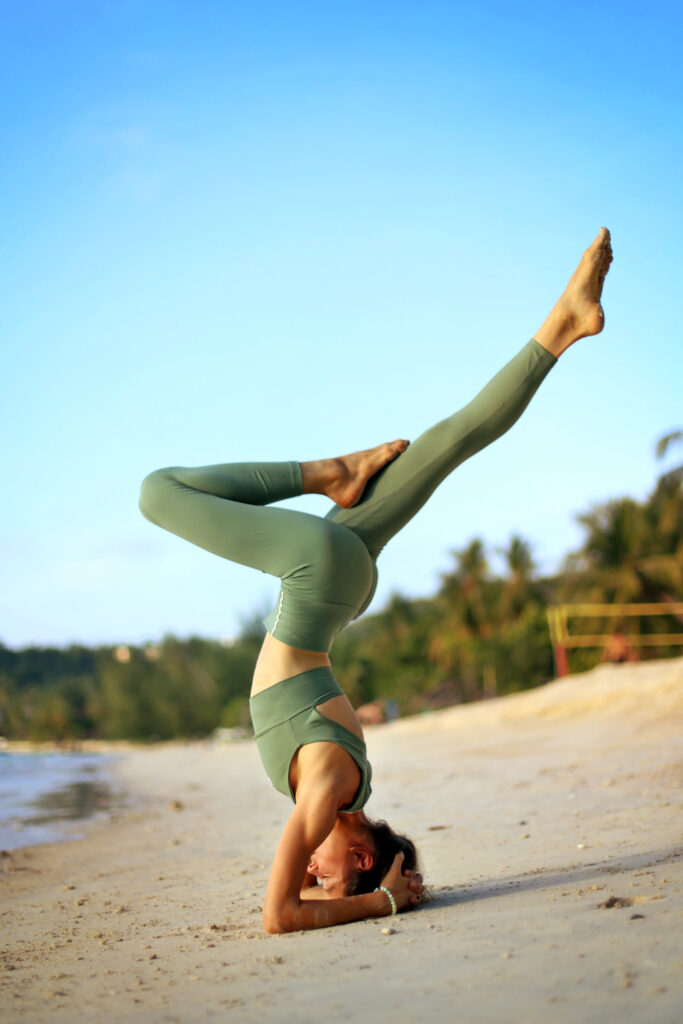Shirsha = head Asana = posture
Sirsasana, the headstand, is considered the most beneficial yoga posture.

Most of time we spend standing or sitting when the head is above our heart and so the muscles become weakened. Because of the constant downward pull of gravity, not only external muscles sag but also internal tissues and organs. Headstand is a kind of inverted pose revitalizing the entire body and mind. It relieves pressure on the internal organs, the increased blood flow helps remove toxins and enhance the flow of prana, a life force energy.
Benefits:
The benefits of headstand are incalculable.
- Sirsasana reverses the effects of gravity on the body. Blood flows through gravity into the head and floods the brain with nourishment. At the same time the blood returns to the heart, which improves circulation.
- The practice of sirsasana increases inner strength.
- Energizes and heats body
- Brings relief from digestive and eliminatory problems
- Helps breath more efficiently
- Stimulates the pineal and pituitary glands. Our growth, health, and vitality depend on the proper functioning of these two glands.
- Drains the lymph system
- Has a tonic effect on the internal organs
- Strengthen the lungs, which relieves the symptoms of colds, coughs, and tonsillitis
- Reduces pressure in the lower back
- Strengthen the spine, shoulders, neck, arms, legs, and core
- alleviates insomnia
- Improves memory and concentration, body-mind coordination
- Calms and focuses the mind
- Alleviates the fatigue of the body
- Headstand is inverted asana having a powerful effect. It draws the life energy up along the central column of the sushumna nadi. It stimulates the upper chakras
- Increases concentration and balance as it stimulates the pressure points at the Sahasrara chakra (crown of the head)
- Improves complexion glow
How to practice
- From Adho Mukha Svanasana (Downward facing dog) drop the knees and elbows to the floor. Reach the hands around the elbows to measure the distance. Interlace all ten fingers together, leaving a hollow space between the palms. Push firmly down through the outside edge of the little fingers and forearms.
- Place the head on the ground with the back of the head against the hands. Raise the hips and slowly walk the feet towards the head. Keep the hips up and knees straight. Back straight.
- Transfer the body weight from the toes on to the head and arms. Raise one foot off the floor, then raise the other one. Bend the knees in towards the chest. Bring the heels up to the buttocks.
- Back straight spine retains natural curve (learn to stay here for 30 seconds before going to next stage). Keeping the knees bent and together, slowly straighten the hips until the front knees are pointing ceiling. Straighten the knees. The spine is in a neutral position. Hold for 15 seconds. Gradually increase the time.
Notes:
- The weight should be in the arms, not in the head.
- The movement should be slow and controlled. No jumps.
- Practicing sirsasana should always be followed by sarvangasana (shoulder stand), which relieves the pressure on the neck.
To come out of the pose:
Bend the knees, bringing them into the chest. Bend the hips, bringing the feet to the floor. Relax in child pose before lifting head off the floor.
Modifications:
- Practice against the wall for support.
- Place blanket over the arms and under the head
The longer you are able to hold the pose, the stronger the effects will be.
Contra-indications:
This pose should not be practised by persons who have spinal injuries and neck problems, high blood pressure, heart disease, headache or migraines, menstruation, pregnancy
Doshic notes:
Kapha with excess weight should practice short repetitions to build strength. Excellent for reducing excess Vata.

